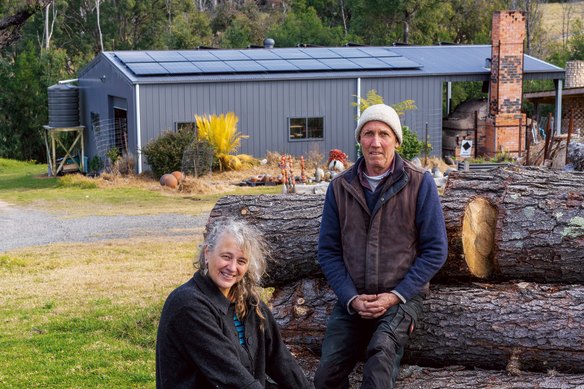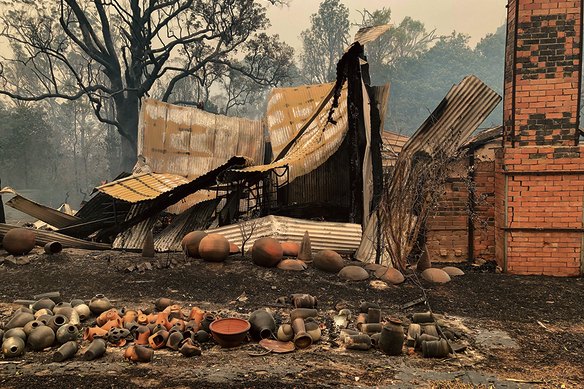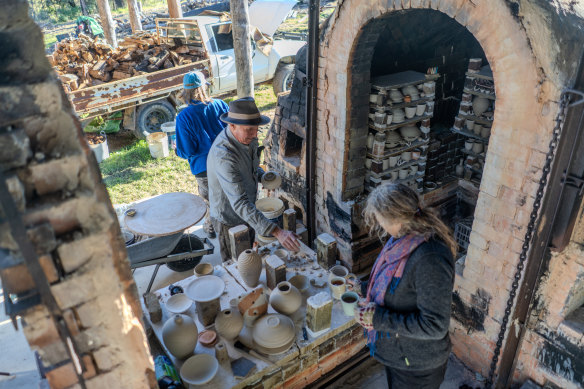Faced with an inferno, Gabrielle had to make a heartbreaking choice
By Melinda Ham
Ceramic artists Daniel Lafferty and Gabrielle Powell are in the midst of working with friends and students pursuing a mutual passion: stoking wood into a large brick kiln that holds more than a thousand pots made from local clay. They’re doing eight-hour shifts for the five-day firing.
The couple’s property is near Cobargo, population 776, about 400 kilometres south of Sydney between Narooma and Bega, a region on the south coast of NSW where the Black Summer fires of 2019 destroyed more than 1000 homes, out of 3000 nationally. Lafferty and Powell successfully defended their home, but their studio, Bandicoot Pottery, was razed.

Ceramic artists Gabrielle Powell and Daniel Lafferty at their rebuilt Cobargo studio.Credit: Matt Nettheim
It took them two years to rebuild, with the support of the local community and strong connections with ceramic artists and potters around Australia. “Since the fires, we have had a positive shift in the community,” Powell says. “We made it through a disaster together and have become more resilient because of it.”
With the help of a GoFundMe campaign and a grant from the Regional Arts Fund Recovery Boost, the couple constructed new, larger sheds framed in steel, replacing the timber studio they had before. They also added concrete water tanks with a capacity of 60,000 litres with pumps connected with copper piping.
“We received donations from all over the world with amazing notes of encouragement,” Powell says. “That was really heartwarming. The ceramics community also pitched in, donating wheels and other studio equipment we’d lost in the blaze.”
Their memories of the fire are still raw. It came upon them quickly at 4am on New Year’s Eve 2019 with a shower of black leaves from the sky and flames raging within 500 metres of their home. “Within 45 minutes it hit us,” says Lafferty.

The original Bandicoot Pottery studio which was destroyed in the 2019 bushfires.
They drove 700 metres to their studio, which has a separate entrance and gate away from the house. All they had time to do was put on sprinklers to hose down piles of firewood. They then faced a stark choice: to save their mudbrick home or the pottery, their livelihood for 30 years. They couldn’t save both.
“Over four years, we had made every brick in our house ourselves,” Powell says. “We are in our 60s and we knew we’d never have the energy to rebuild it like that again.”
A month before the fires, the couple had taken measures to protect the house as they were in the midst of a 10-year drought, clearing their yard of dry debris and putting sprinklers on fence posts that could pump water straight out of the dam.
They’d also converted a Toyota Hilux truck with no windscreen that had crashed into an ad hoc firetruck with PVC tub and pump on the back. But it couldn’t save the studio.

‘Everyone wants to touch clay’: Bandicoot Pottery studio. Credit: Matt Nettheim
They made it home and kept defending the house for hours, putting out spot fires, with blazes now coming from two directions.
“The fire formed into a pyrocumulus cloud from fully grown gum trees burning 100 metres high. A big bolt of lightning went through it and then thunder went off. It was incredible,” Lafferty says.
After the fire eventually subsided, they realised how lucky they had been. “So many people were much worse off,” Powell says. “We had saved our house, even though we lost our studio, our sheds, our work, our tools and some of our vehicles. Three neighbours lost their homes and everything they owned.”
Nationally, the fires burned a fifth of Australia’s temperate forests, killed nearly 3 billion native animals and birds, and caused the deaths of 33 people, including firefighters and people defending their homes.
The fires did have a silver lining because they led to a creative upsurge in the community, Powell says. This included the Painted Pole Project, which rallied local artists together to paint 88 electricity poles in Cobargo. Meanwhile, the Spiral Gallery, an artists-run co-operative in Bega, held various community art exhibitions with proceeds going to the region’s recovery.
At Bandicoot Pottery, for the first time, they also started holding pottery and basket weaving classes for the community, with grants from Create NSW. This included a women’s recovery project so participants could make tableware for their homes, destroyed in the fires. Other classes were for homeschooled children, youth and school holiday programs.
“Visitors also come from Batemans Bay, Eden, Cooma and Canberra, even Wollongong, to attend classes,” Lafferty says. “It seems everyone wants to touch clay.”